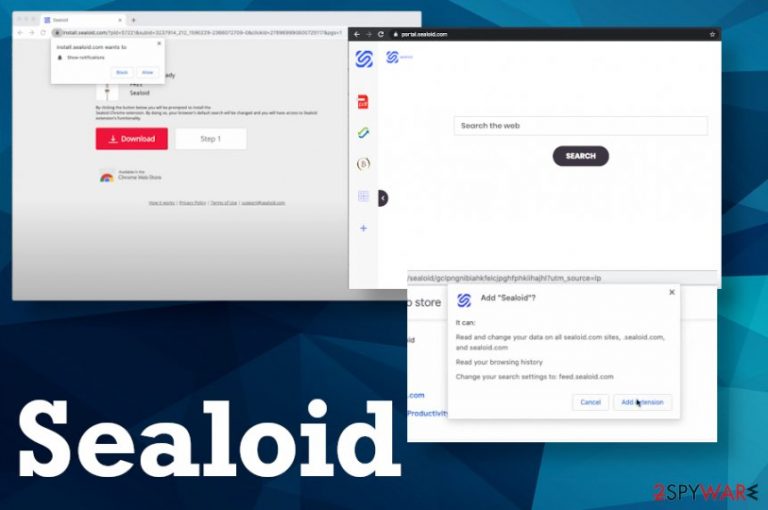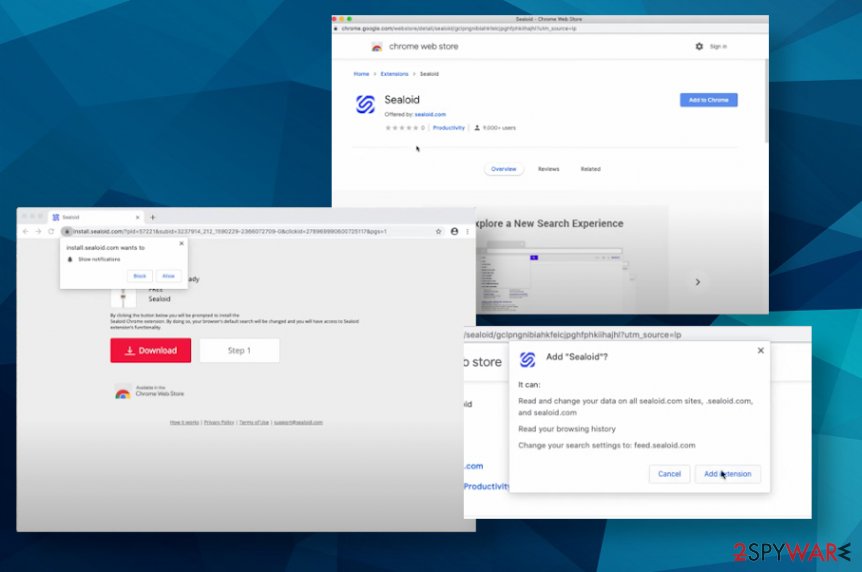Sealoid (Free Guide) - Chrome, Firefox, IE, Edge
Sealoid Removal Guide
What is Sealoid?
Sealoid is the suspicious search engine that redirects your online traffic and triggers installs of questionable browser components

Sealoid – a browser hijacker that alters homepage settings, new tab, and default search engine preferences to affect the traffic and speed, the performance of the infected machine. This browser-based program categorizes as a hijacker because it alters browser settings to promote the fake search engine that operates via sealoid.com. This site appears as a default site for all the searches on the web browser as soon as the PUP enters the system. Unfortunately, the installation of this threat happens stealthily and without proper users' permission. In most cases, such hijackers or adware-type intruders get bundled with freeware programs and manage to get the download on the machine when the person pays less than attention to installation options than needed.
Sealoid Search operates as a promotional tool also because it shows altered results of online searches and injects sponsored material there or affiliated links, pop-ups, banners with related advertisements, and page redirects to third-party websites. All these additional pop-ups and new tabs expose the user to unwanted content that has the function of data tracking. Users' information regarding browsing preferences, habits while surfing online gets accessed and gathered by various advertisers and companies.
Unfortunately, this behavior is not controlled by the Sealoid PUP developers, and anything related to third-parties can lead to more issues with the device, security, or privacy. Due to all this involvement and questionable proliferation methods, you should consider the search engine and its tools, extensions, toolbars a potentially dangerous application.
| Name | Sealoid |
|---|---|
| Type | Browser hijacker |
| Symptoms | Searches on the web browser show altered results filled with advertisements. All the preferences like a search engine, homepage, new tab get set to Sealoid site. PUP triggers installation of other tools and applications |
| Danger | The PUP is involved in third-party advertising campaigns and data tracking activities[1] and can expose the user to possibly malicious material online |
| Distribution | Freeware installations, bundling methods, and torrent sites or other PUP-related pages lead to infiltration of such hijackers |
| Elimination | Sealoid removal should involve anti-malware tools that can check the system fully for any intruders and possible risks |
| Repair | There is a possibility that PUP manages to enter or delete registry entries, change other settings, so you should rely on FortectIntego or different PC repair tools, so these alterations get fixed and corrupted files recovered |
Sealoid virus is the possible term that victims tend to use while describing this search engine. It is common due to the questionable behavior of this PUP. It can easily infiltrate the system, affect Google Chrome, Mozilla Firefox, Internet Explorer, Safari, or another web browser, and trigger all the intrusive symptoms. This program provides no value because searches are not improved when content for monetization purposes gets injected on the list every time.
Since Sealoid PUP infiltrates the machine behind your back, you cannot notice anything until those real symptoms start to show up on the web browser. You should immediately take action once that happens because PUP can run in the background and affect some additional settings before triggering noticeable activities.
Possible Sealoid Search infiltration symptoms and features that typically PUP has:
- web browser's default search engine changed to sealoid.com;
- search queries get redirected to feed.sealoid.com;
- Sealoid browser extension gets promoted on various pop-ups or appears installed without permission or warning;
- other toolbars and plugins get installed on web browsers out of nowhere;
- advertisements appear on sites where commercial material is not typically found;
- clicking on any banner or pop-up redirects to more commercial pages where deals and offers fill up the screen constantly.
Sealoid gets downloaded from the internet, so it is common for PUPs to infiltrate other browser-based threats on the machine that is already affected. This is why you should go for the full system scan and thorough system cleaning process, when you encounter any symptoms of the browser hijacker. A full system check using an antivirus program can show you all the intruders and terminate them. 
In most cases, Sealoid extension is the main intruder, so it gets even difficult to find the reason behind all the performance interruptions. Unfortunately, it is not enough to uninstall the extension to get rid of all the symptoms because the main PUP is running the background and controlling behavior from there.[2]
You can remove Sealoid by using proper anti-malware tools that scan the machine and can find those potentially unwanted programs, files associated with annoying and intrusive processes. This is how you clean the device and can be sure that privacy issues are avoided.
When you for such automatic Sealoid removal with AV detection engines, experts[3] note that you improve the system significantly. However, these tools terminate threats and malware that can damage the system, so you avoid identity theft or financial losses.
To ensure the integrity of the system you should clear browsers manually by eliminating Sealoid, other PUPs directly from the browsers. You can do that by relying on the guide below that shows how to reset them to default. Also, tools like FortectIntego can help recover the machine fully to proper performance by repairing affected system files. 
The typical potentially unwanted program infiltration
PUP developers use deceptive methods to spread these tools on machines because people can install browser hijackers and adware on their computers themselves. In most cases, they are not aware of software bundling functions and all the features that extension or the program their download has eventually.
If you recently installed any system optimization program or application front he internet, you may trigger the infiltration yourself. It happens when Quick or Recommended options get chosen instead of Advanced or Custom installations because all the additional features and applications included for the download get hidden this way.
When you expand the list and see all the programs, you can choose what to install and what applications to cancel. This how you avoid getting PUPs and hijackers. You should always ensure that you do everything to avoid such threats. Relying on official sources and using anti-malware tools could help with that too.
Treat Sealoid PUP as a cyber threat and clean it using an antivirus program
The name Sealoid virus shouldn't be used often since this is not a malicious program or malware of any sort. The hijacker is running as a browser extension too, can possibly install system programs and affect various settings on all the web browsers. This is why you need to clear the system fully.
The best way to remove Sealoid completely is an automatic scan and cleaning process on the machine. You can use security tools or anti-malware programs and check the machine for any risky apps and files. The problem with PUPs is universal, so the anti-malware applications can indicate various associated programs and remove them for you.
Sealoid removal can be quick if the potentially unwanted program affected only a small part of the system. If your web browsers got affected and the AV tool managed to find and terminate the hijacker quickly, you need to rest those browsing tools to default and run the PC repair or optimization software to make sure that all the functions can run smoothly. This is how you complete the PUP elimination.
You may remove virus damage with a help of FortectIntego. SpyHunter 5Combo Cleaner and Malwarebytes are recommended to detect potentially unwanted programs and viruses with all their files and registry entries that are related to them.
Getting rid of Sealoid. Follow these steps
Uninstall from Windows
Terminate Sealoid fully by following these steps
Instructions for Windows 10/8 machines:
- Enter Control Panel into Windows search box and hit Enter or click on the search result.
- Under Programs, select Uninstall a program.

- From the list, find the entry of the suspicious program.
- Right-click on the application and select Uninstall.
- If User Account Control shows up, click Yes.
- Wait till uninstallation process is complete and click OK.

If you are Windows 7/XP user, proceed with the following instructions:
- Click on Windows Start > Control Panel located on the right pane (if you are Windows XP user, click on Add/Remove Programs).
- In Control Panel, select Programs > Uninstall a program.

- Pick the unwanted application by clicking on it once.
- At the top, click Uninstall/Change.
- In the confirmation prompt, pick Yes.
- Click OK once the removal process is finished.
Delete from macOS
Remove items from Applications folder:
- From the menu bar, select Go > Applications.
- In the Applications folder, look for all related entries.
- Click on the app and drag it to Trash (or right-click and pick Move to Trash)

To fully remove an unwanted app, you need to access Application Support, LaunchAgents, and LaunchDaemons folders and delete relevant files:
- Select Go > Go to Folder.
- Enter /Library/Application Support and click Go or press Enter.
- In the Application Support folder, look for any dubious entries and then delete them.
- Now enter /Library/LaunchAgents and /Library/LaunchDaemons folders the same way and terminate all the related .plist files.

Remove from Microsoft Edge
Delete unwanted extensions from MS Edge:
- Select Menu (three horizontal dots at the top-right of the browser window) and pick Extensions.
- From the list, pick the extension and click on the Gear icon.
- Click on Uninstall at the bottom.

Clear cookies and other browser data:
- Click on the Menu (three horizontal dots at the top-right of the browser window) and select Privacy & security.
- Under Clear browsing data, pick Choose what to clear.
- Select everything (apart from passwords, although you might want to include Media licenses as well, if applicable) and click on Clear.

Restore new tab and homepage settings:
- Click the menu icon and choose Settings.
- Then find On startup section.
- Click Disable if you found any suspicious domain.
Reset MS Edge if the above steps did not work:
- Press on Ctrl + Shift + Esc to open Task Manager.
- Click on More details arrow at the bottom of the window.
- Select Details tab.
- Now scroll down and locate every entry with Microsoft Edge name in it. Right-click on each of them and select End Task to stop MS Edge from running.

If this solution failed to help you, you need to use an advanced Edge reset method. Note that you need to backup your data before proceeding.
- Find the following folder on your computer: C:\\Users\\%username%\\AppData\\Local\\Packages\\Microsoft.MicrosoftEdge_8wekyb3d8bbwe.
- Press Ctrl + A on your keyboard to select all folders.
- Right-click on them and pick Delete

- Now right-click on the Start button and pick Windows PowerShell (Admin).
- When the new window opens, copy and paste the following command, and then press Enter:
Get-AppXPackage -AllUsers -Name Microsoft.MicrosoftEdge | Foreach {Add-AppxPackage -DisableDevelopmentMode -Register “$($_.InstallLocation)\\AppXManifest.xml” -Verbose

Instructions for Chromium-based Edge
Delete extensions from MS Edge (Chromium):
- Open Edge and click select Settings > Extensions.
- Delete unwanted extensions by clicking Remove.

Clear cache and site data:
- Click on Menu and go to Settings.
- Select Privacy, search and services.
- Under Clear browsing data, pick Choose what to clear.
- Under Time range, pick All time.
- Select Clear now.

Reset Chromium-based MS Edge:
- Click on Menu and select Settings.
- On the left side, pick Reset settings.
- Select Restore settings to their default values.
- Confirm with Reset.

Remove from Mozilla Firefox (FF)
Remove dangerous extensions:
- Open Mozilla Firefox browser and click on the Menu (three horizontal lines at the top-right of the window).
- Select Add-ons.
- In here, select unwanted plugin and click Remove.

Reset the homepage:
- Click three horizontal lines at the top right corner to open the menu.
- Choose Options.
- Under Home options, enter your preferred site that will open every time you newly open the Mozilla Firefox.
Clear cookies and site data:
- Click Menu and pick Settings.
- Go to Privacy & Security section.
- Scroll down to locate Cookies and Site Data.
- Click on Clear Data…
- Select Cookies and Site Data, as well as Cached Web Content and press Clear.

Reset Mozilla Firefox
If clearing the browser as explained above did not help, reset Mozilla Firefox:
- Open Mozilla Firefox browser and click the Menu.
- Go to Help and then choose Troubleshooting Information.

- Under Give Firefox a tune up section, click on Refresh Firefox…
- Once the pop-up shows up, confirm the action by pressing on Refresh Firefox.

Remove from Google Chrome
Make the Chrome free of any suspicious programs by resetting the browser to default
Delete malicious extensions from Google Chrome:
- Open Google Chrome, click on the Menu (three vertical dots at the top-right corner) and select More tools > Extensions.
- In the newly opened window, you will see all the installed extensions. Uninstall all the suspicious plugins that might be related to the unwanted program by clicking Remove.

Clear cache and web data from Chrome:
- Click on Menu and pick Settings.
- Under Privacy and security, select Clear browsing data.
- Select Browsing history, Cookies and other site data, as well as Cached images and files.
- Click Clear data.

Change your homepage:
- Click menu and choose Settings.
- Look for a suspicious site in the On startup section.
- Click on Open a specific or set of pages and click on three dots to find the Remove option.
Reset Google Chrome:
If the previous methods did not help you, reset Google Chrome to eliminate all the unwanted components:
- Click on Menu and select Settings.
- In the Settings, scroll down and click Advanced.
- Scroll down and locate Reset and clean up section.
- Now click Restore settings to their original defaults.
- Confirm with Reset settings.

Delete from Safari
Remove unwanted extensions from Safari:
- Click Safari > Preferences…
- In the new window, pick Extensions.
- Select the unwanted extension and select Uninstall.

Clear cookies and other website data from Safari:
- Click Safari > Clear History…
- From the drop-down menu under Clear, pick all history.
- Confirm with Clear History.

Reset Safari if the above-mentioned steps did not help you:
- Click Safari > Preferences…
- Go to Advanced tab.
- Tick the Show Develop menu in menu bar.
- From the menu bar, click Develop, and then select Empty Caches.

After uninstalling this potentially unwanted program (PUP) and fixing each of your web browsers, we recommend you to scan your PC system with a reputable anti-spyware. This will help you to get rid of Sealoid registry traces and will also identify related parasites or possible malware infections on your computer. For that you can use our top-rated malware remover: FortectIntego, SpyHunter 5Combo Cleaner or Malwarebytes.
How to prevent from getting browser hijacker
Stream videos without limitations, no matter where you are
There are multiple parties that could find out almost anything about you by checking your online activity. While this is highly unlikely, advertisers and tech companies are constantly tracking you online. The first step to privacy should be a secure browser that focuses on tracker reduction to a minimum.
Even if you employ a secure browser, you will not be able to access websites that are restricted due to local government laws or other reasons. In other words, you may not be able to stream Disney+ or US-based Netflix in some countries. To bypass these restrictions, you can employ a powerful Private Internet Access VPN, which provides dedicated servers for torrenting and streaming, not slowing you down in the process.
Data backups are important – recover your lost files
Ransomware is one of the biggest threats to personal data. Once it is executed on a machine, it launches a sophisticated encryption algorithm that locks all your files, although it does not destroy them. The most common misconception is that anti-malware software can return files to their previous states. This is not true, however, and data remains locked after the malicious payload is deleted.
While regular data backups are the only secure method to recover your files after a ransomware attack, tools such as Data Recovery Pro can also be effective and restore at least some of your lost data.
